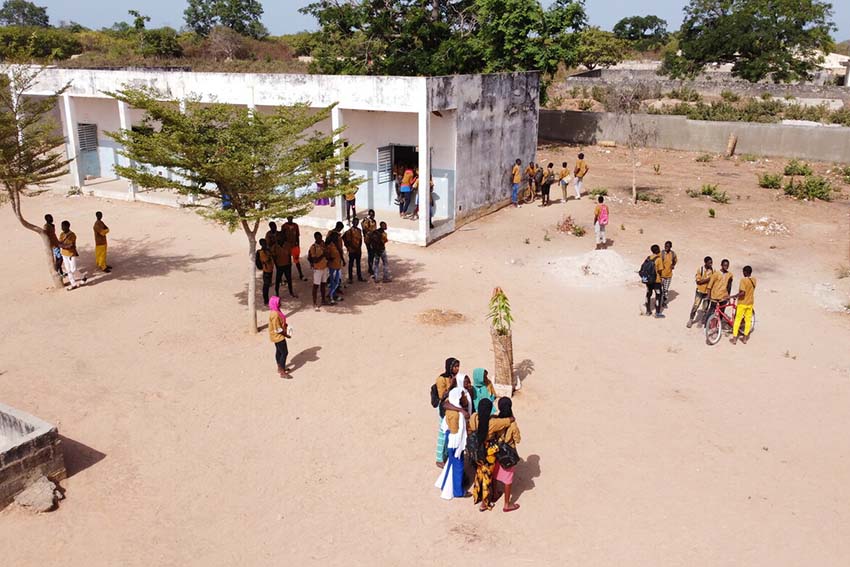
Students socialize with one another in a school courtyard in Karantaba, Senegal. Photo credit: Alpha Gano for FHI 360
Discussion of climate change typically involves natural phenomena: raging wildfires, record flooding, ruinous drought. Less frequently examined, but equally important, is the effect of our warming planet on a child’s right to education.
UNICEF has estimated that almost half of the world’s 2.2 billion children live in countries that are at “extremely high risk” due to the effects of climate change (such as record high temperatures, coastal flooding, drought and pollution), but no educational system on the planet has been spared these impacts. Last year (the planet’s warmest since recording began in 1850), extreme heat forced schools across the United States to switch to remote learning. In India, Bangladesh and the Canary Islands, schools were closed amid prolonged heatwaves.
“Extreme heat is the deadliest of all extreme weather phenomena,” Eleni Myrivili, who is now the global chief heat officer at UN-Habitat, said in a 2022 TED Talk. “We overlook extreme heat, because heat doesn’t come with the drama of roofs sent flying and streets turned into rivers. Heat destroys quietly.
“Yet there is little escape from heat. These are temperatures our bodies are not made for and cannot adapt to,” she said, noting that heat waves “lower the ability of children to learn.”
Hot classrooms impair cognitive development, reducing learners’ ability to concentrate and process and retain information. Test scores drop as the thermometer rises, as found by the Program for International Student Assessment, which measures the scholastic performance of 15-year-olds around the world.
For every 1-degree Fahrenheit (0.56 degree Celsius) rise in temperature, experts estimate a learning loss of 1 percent, reducing a child’s academic achievement by 4 to 7 percent annually. The problem is one of inequity: Areas predisposed to hotter climates or at higher risk of disasters are where the world’s most vulnerable populations tend to live.
At stake are the substantial gains achieved in recent decades in bringing more children, especially girls, to school and keeping them there. We know that educating girls is key to reducing poverty and creating stable societies, as well as improving resilience to climate change. But girls are missing more school due to reduced access to water, sanitation and hygiene — all byproducts of climate change. By next year, climate change is expected to contribute to at least 12.5 million girls failing to complete their education annually.
Meanwhile, teachers are suffering in unhealthy work environments, leading to lower productivity and more sick leave. And they face barriers to teaching the science of climate change, including a lack of training and ideological differences that preclude instruction.
But strengthening students’ knowledge about global warming is among the best means of tackling it. Studies of secondary school students in high- and middle-income countries show a correlation between climate change education and a reduction in carbon dioxide.
That is why the Global Response to Education and the Environment Network (GREEN), hosted by FHI 360, has brought together international NGOs, civil society organizations and other stakeholders to advance research and communication to inform policy, programming and practice at the nexus of education and resilience to climate change.
Political awareness of the link between climate and education is growing. At COP28 in December, more than two dozen countries adopted the Declaration of the Common Agenda for Education and Climate Change, a landmark pledge by nations to incorporate education into their climate strategies.
Now it’s time to go from policy to implementation. We must avoid siloes and build partnerships between international nongovernmental organizations, local climate action organizations, municipalities, government entities, and donors to strengthen emergency preparedness and response systemically while drawing on local knowledge to bring real change into schools and their communities.
We know how to teach climate change in schools, with instruction materials available for free, and how to reduce heat stress on schools. In the village of Lilapur in India’s Gujarat state, the local NGO Mahila Housing Trust worked with the community to build its learning center, installing an eco-friendly modular roof to reduce heat by 6 degrees Celsius. One wall blocks out the sun; the other lets in natural light and ventilation.
Schools do not exist in isolation. When extreme heat leads to poor harvests, families have less food, putting children at risk of malnutrition and harming their ability to learn. The effects of climate change can also prompt families to withdraw their children from school [PDF] to work for new sources of income. Extreme weather forces families to migrate, and climate shocks have displaced 13 million school-aged children since 2020. That break with school is often permanent.
These disruptions to education only deepen our environmental crisis. The future of young people and the future of the planet are inextricably linked. The solution must begin in our schools.
